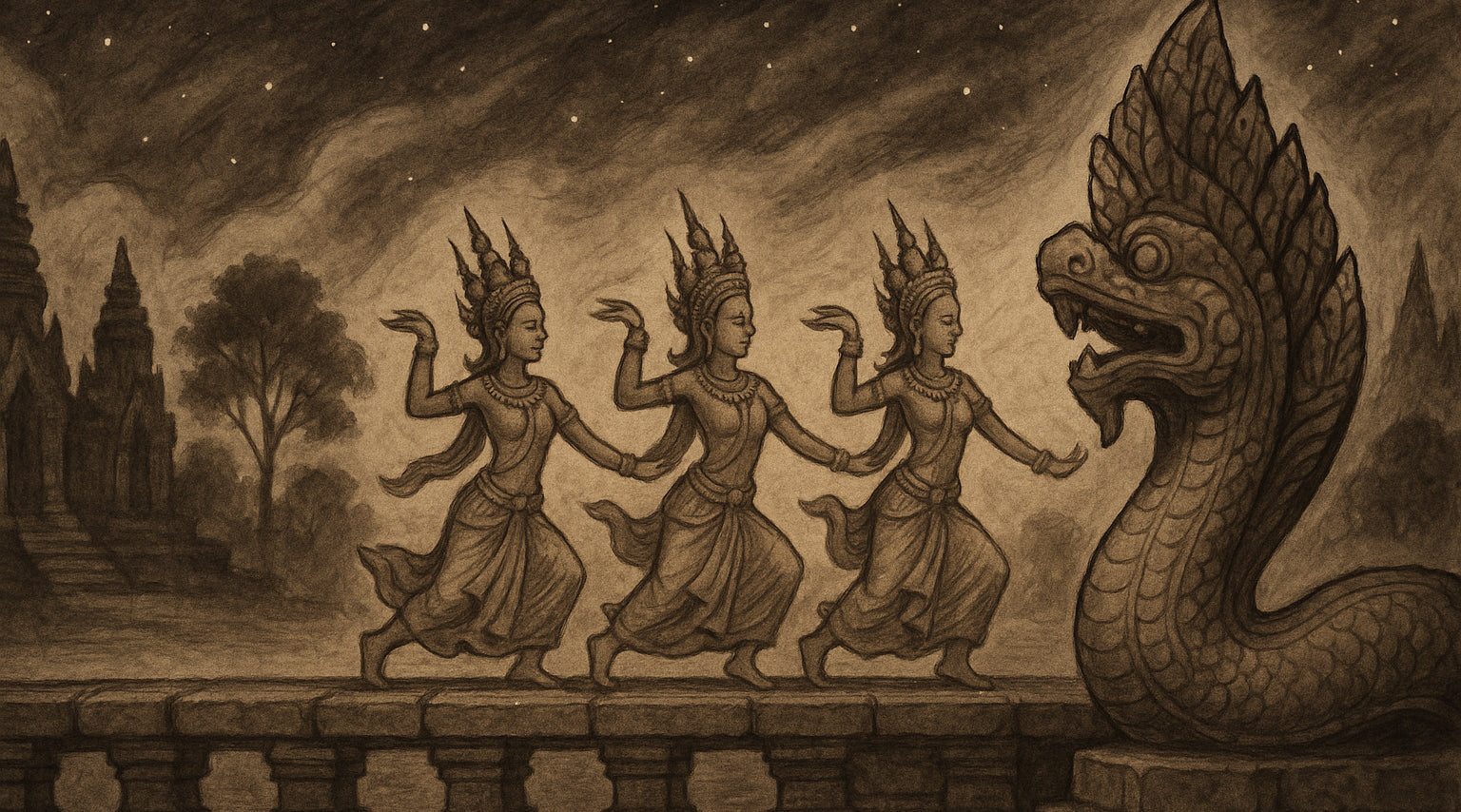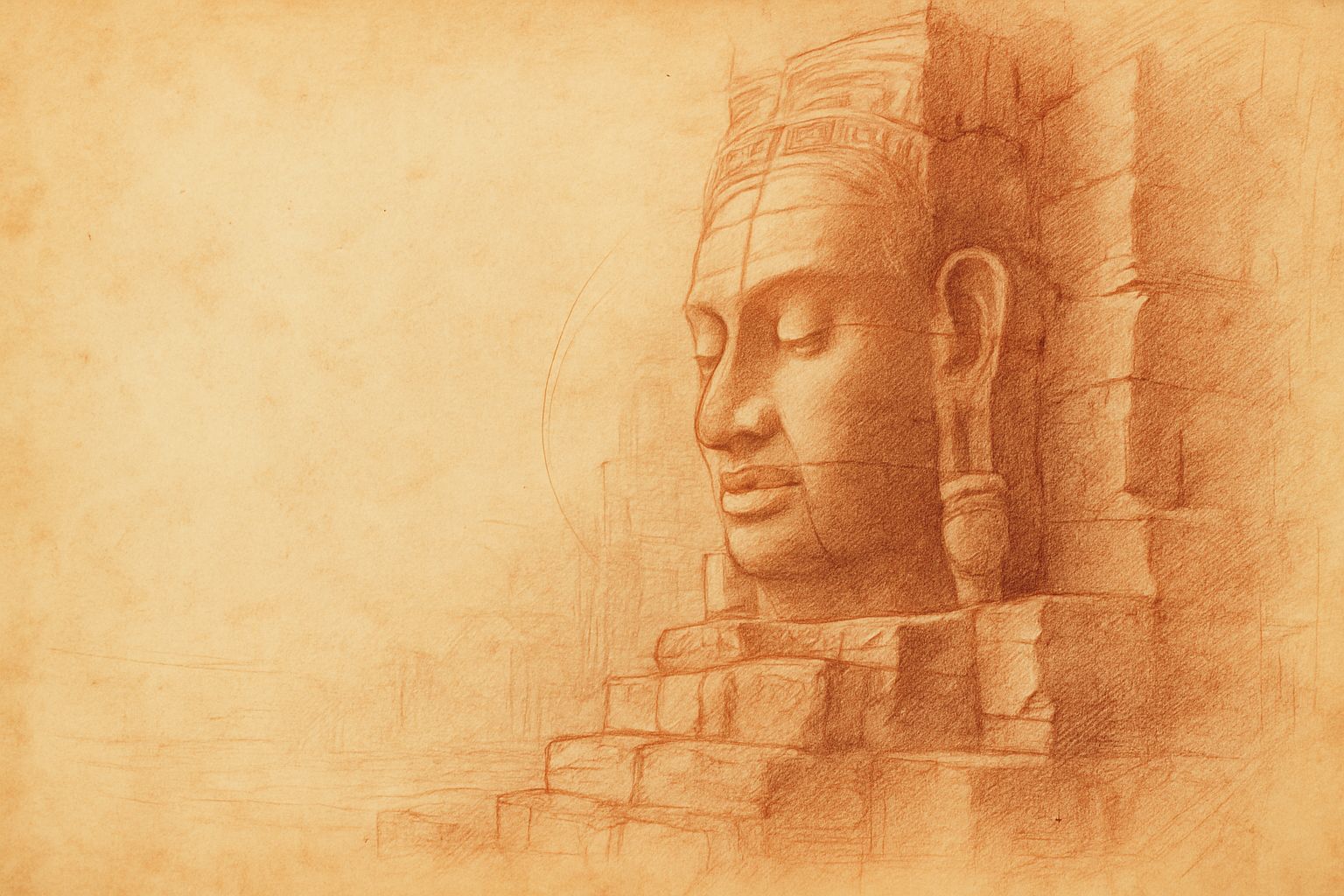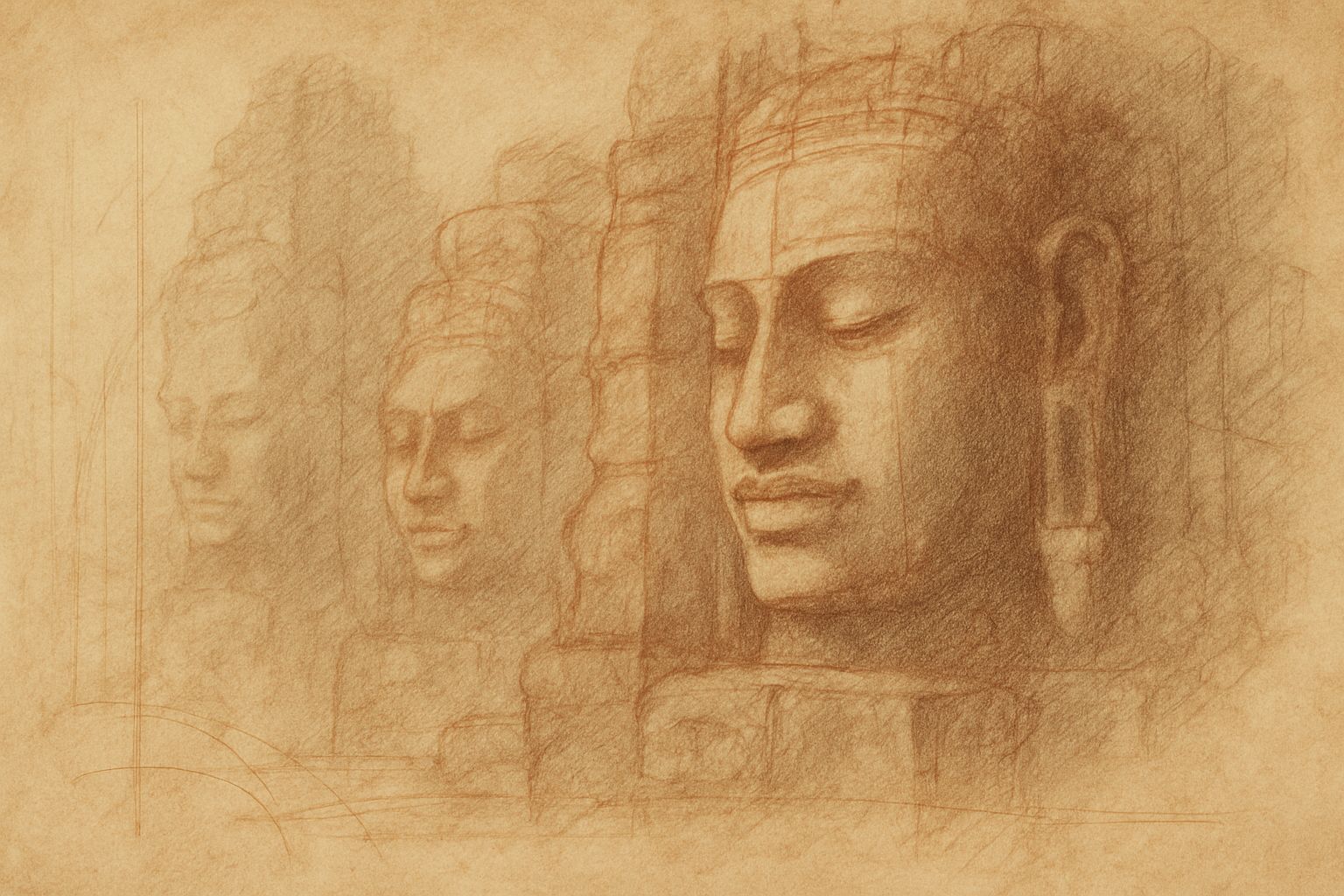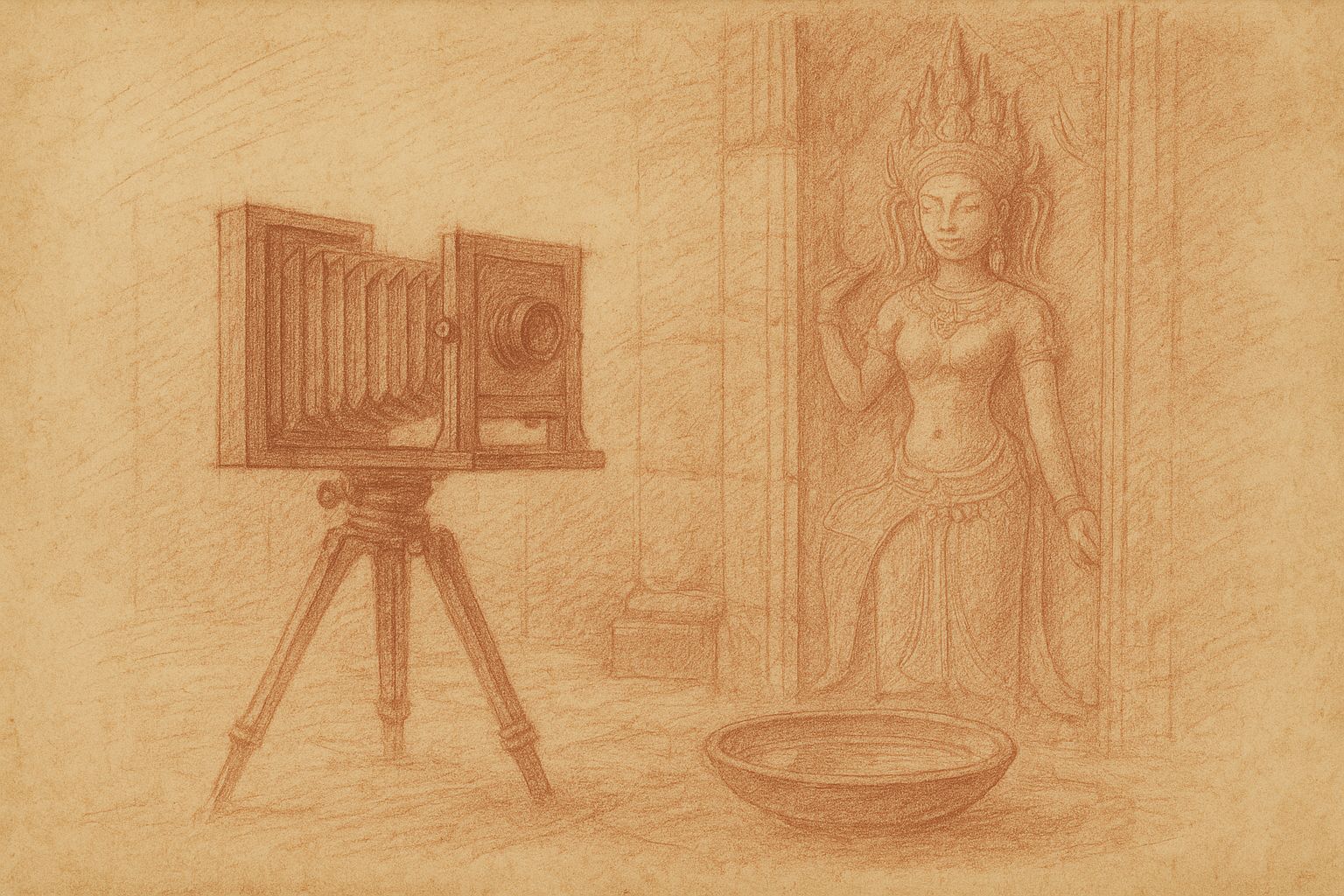Complimentary worldwide shipping on orders over $400 · No import tariffs for most countries
Complimentary worldwide shipping on orders over $400 · No import tariffs for most countries

When Stone Breathes the Name of Gods
3 min read
“From silence the form arises, from form the sacred breath.”
In Angkor, stone does not merely rest. It murmurs softly, chants that arose before memory began. Each figure carved upon sandstone walls and pillars arises from an ancient impulse—to render visible the invisible, to invite the divine into tangible presence. Here, images transcend mere adornment; they become vessels holding the whispered breath of gods.
The creation of sacred images has always emerged from longing—a profound yearning to transcend the mundane, to touch the divine through vision and reverence. At Angkor, this longing crystallised into stone, shaped by deep spiritual devotion. Khmer artists did not simply adopt gods from distant lands; they reimagined them, breathing indigenous life into borrowed forms until Vishnu, Shiva, and the Buddha resonated distinctly in Khmer rhythms. What began as reverent emulation soon blossomed into sacred poetry, etched with quiet devotion upon stone.
Within the temples, these sacred images abide in profound stillness, as though eternally immersed in meditation. Their tranquillity is no mere accident—it is the fruit of meticulous adherence to sacred texts, the shilpashastras, which prescribed every subtle nuance of divine form, from the curve of a gesture to the enigmatic angle of a divine smile. Yet, within this adherence lay boundless creativity. Each image first bloomed in the contemplative heart of the sculptor, cultivated through disciplined meditation and prayer. Only when the vision was radiant and complete within the artist’s spirit did the chisel dare to touch the stone. Thus, each deity embodies both divine presence and human devotion.
Consider the apsaras, celestial dancers carved with such delicate grace they seem poised to step gently from their niches. Their beauty is not mere artistry; it is holiness itself made visible. Serene visages and elegantly poised hands evoke the sacred dance of creation—a movement sustaining cosmic harmony and human hearts alike. In their subtle smiles and softly inclined heads, one senses the tenderness of a cosmos watched lovingly by benevolent forces.
In Angkor Wat, narrative reliefs drawn from the Ramayana and Mahabharata adorn gallery walls, serving not only to recount epic tales but to affirm kingship's divine nature. Here, temporal authority and spiritual grace intertwine seamlessly. Kings such as Suryavarman II and Jayavarman VII profoundly understood this power, crafting temples wherein architecture and sacred imagery merge into a singular expression of divine kingship.
The Bayon, crafted under Jayavarman VII’s visionary gaze, exemplifies this spiritual unity. Here, the boundaries between architecture and divine image dissolve completely. Serene faces of Lokeshvara blend effortlessly with temple towers, making each corridor and gateway sacred. Every stone becomes divine presence embodied. Bayon’s multiple faces evoke Shiva and Buddha simultaneously, expressing the Khmer insight of these figures as twin facets of universal compassion and transcendent consciousness.
This profound spiritual synthesis allowed Jayavarman VII to manifest supreme authority. By intertwining Hindu and Buddhist symbolism within Bayon’s sacred architecture, the temple transcended mere sanctuary, becoming a mandala of Khmer cosmology and kingship—an intricate sacred geometry carved into living stone.
Yet, despite their majesty, these images were not crafted for eternal material permanence. Their true essence was ephemeral and mystical—a vessel momentarily inhabited by the divine. Ritual consecration, sacred mantras, and the gentle sprinkling of holy waters breathed life into stone, inviting divine presence. In those fleeting sacred instants, stone breathed, eyes opened, and divinity became tangible.
What, then, remains of these stone images, now quieted and softened by centuries? Perhaps their enduring power lies not in material permanence, but in the quiet resonance of devotion etched by unseen hands. They remain powerful precisely because they gesture beyond themselves toward eternity that briefly alighted among them.
Even now, walking through temple grounds at dawn or dusk, one senses gods lingering quietly. Stones seem to hold memory, whispering sacred names to those who pause to listen. In this stillness, in the spaces between breaths, Angkor lives—a sanctuary where stone, spirit, and silent devotion commune timelessly.
Stone listens still, remembering gods who once touched eternity.
Also in Library

Multiplicity and Mercy — The Face Towers of Jayavarman VII
5 min read
A new vision of kingship rises at the Bayon: serene faces turned to every horizon, shaping a world where authority is expressed as care. Moving through the terraces, one enters a field of steady, compassionate presence — a landscape where stone, light, and time teach through quiet attention.

Stone That Dreams
4 min read
Bayon wakes like a mind emerging from shadow. Its many faces shift with light and breath, teaching that perception—and the self—is never singular. In walking this forest of towers, the pilgrim discovers a quiet multiplicity within, held together by a calm that feels both ancient and newly understood.

The Still Eye — Craft, Meditation, and the Listening Camera
4 min read
In the darkroom, silver begins to breathe—and a morning at Bayon returns. The essay moves from tray to temple and back, tightening its centre around a single vow: consent, not capture. A butterfly’s tremor, a lintel at dawn, a print clearing in water. Craft becomes meditation; the camera, a quiet bowl for light.
Join My Studio Journal
Receive occasional letters from my studio in Siem Reap—offering a glimpse into my creative process, early access to new fine art prints, field notes from the temples of Angkor, exhibition announcements, and reflections on beauty, impermanence, and the spirit of place.
No noise. No clutter. Just quiet inspiration, delivered gently.
Subscribe and stay connected to the unfolding story.

Join My Studio Journal
Receive occasional letters from my studio in Siem Reap—offering a glimpse into my creative process, early access to new fine art prints, field notes from the temples of Angkor, exhibition announcements, and reflections on beauty, impermanence, and the spirit of place.
No noise. No clutter. Just quiet inspiration, delivered gently.
Subscribe and stay connected to the unfolding story.
